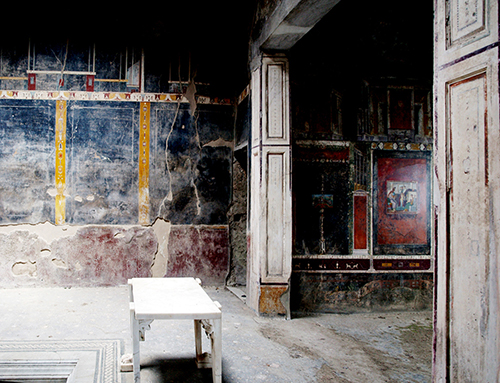 1
1Some ancient literary references to buildings as icons of decadence are so poetically oblique that they are only decipherable by Latin philologists. For example, in the Aeneid Virgil conjures up a cinematically vivid slow motion image of the warrior Bitias falling mortally wounded to the ground. The gravitas of this moment is emphasised by likening him to a building sinking into the sea and causing a turbulent displacement. The place in which he chose to locate this momentous event was Baiae, a place noted for its lavish marble colonnaded villas perched on the shoreline. ‘The giant limbs collapsed and sank; earth groaned, and the huge shield thundered as it fell on its bearer. So falls sometimes a rock-like pile which, built beforehand of massive masonry, men launch into the deep at Cumae on the Bay of Baiae; plunging, it trails just such a havoc behind, smashes into shallow waters and settles on the sea-bed as the sea swirls in turmoil and the dark sand is stirred’. (Virgil Aeneid IX. 710-13)
Wall-painting, unlike marble, did not feature in ancient discourses on conspicuous consumption. We had to wait until the 1980s for that discourse to emerge. Undeterred, contemporary writers began to ascribe to wall-painting the same polemical issues that were once associated with marble. Consequently, many hold the view that the paintings are purely luxury items acquired with the sole purpose of enhancing social status. The Social life of Painting in Ancient Rome and on the Bay of Naples by Eleanor W. Leach, 2004, is underpinned by this approach. Pejorative discourses on marble form a significant part of Chapter five ‘The Style of Luxury’. The relevance of this discourse with regard to wall-painting is never clearly explained, but the result is that via osmotic association they become attached to ancient debates concerning marble and luxury. This is exemplified by associating wall-paintings in relatively modest houses in Pompeii, such as that of Lucretius Fronto, with the type of luxury found in Neronian palatial interiors decorated with marble fixtures (fig.1). Veneered marble walls and solid marble columns, as Leach herself acknowledges, were a rarity in Pompeii, but this observation did not prevent her from attaching Pompeian painting to the polemical debates surrounded the ostentatious use of marble elsewhere. (Leach 2004:176)
The capacity that paint has to mimic luxury items such as marble architecture has caused it to become a key part of modern discourses concerning the Roman pursuit of luxury. This may seem a reasonable association, but when applied to Pompeian painting it leads to surprising results. For example, if the pictorial representation of marble is cited as a major criteria for the presence of luxury, then the First or ‘Incrustation’ Style would win hands down, since it appears to be entirely concerned with mimicking marble veneer (fig.2). And yet, the depiction of luxury is more often ascribed to the later Pompeian styles, because they supposedly depicted ‘luxury’ objects in ornate architectural settings. However, the iconological significance of the later wall-paintings is seldom defined, with the result that they are detached from any inherent semantic that they may have once possessed. Once detached, they are then exposed to virtually any form of contextualisation. For example, the publication cited above associates the wall-paintings with polemical discourses on the opulent use of marble in order to label them as ‘luxury items’, which we are then told the ‘elite’ used to demonstrate their elite status. However, the ubiquitous presence of exceptional paintings throughout Pompeii, in both large and small houses, mitigates against their use as a form of elite social engineering.
 1
11 Casa di Marcus Lucretius Fronto, view into triclinium and tablinum, Pompeii
2 Example of 'Frist Style' wall-painting, Palermo Archaeological Museum
|